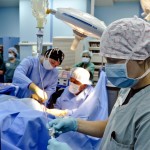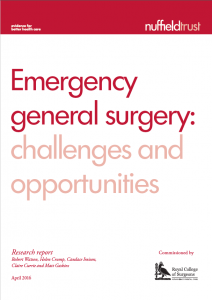
Demand for emergency general surgery is on the up and creative solutions are needed to manage growing volumes of activity and increasingly complex case mix in an environment of significant provider deficits.
Commissioned by the Royal College of Surgeons, this report from the Nuffield Trust suggests some options for consideration.
Methods
The report is based on:
- a series of interviews with 12 experts;
- a rapid literature review;
- a retrospective quantitative analysis of activity and outcome data over 4 years;
- stakeholder engagement.
Results
The findings point to a number of drivers that are impacting demand and capacity:
- financial pressures;
- fewer doctors in training;
- increased specialisation;
- 24/7 consultant delivered care;
- tensions between service delivery pressures and provision of training opportunities.
The report authors were keen to unpack the longstanding debate on volume and outcomes of centralised versus local access – reconfiguration programmes often focus on the centralisation of surgical specialties on the premise that higher volumes lead to better patient outcomes but earlier work has found variable evidence and difficulties in determining clear thresholds. The debate is likely to continue, however, as the authors didn’t find a clear relationship and suggest our understanding of the impact of centralisation on patient outcomes remains poor.
They point to significant variation in outcomes across different sites and surgeons, citing the example of emergency laparotomy where mortality ranged from 3.6 – 41.7%; some of this variation may be explainable but it does help to shine a spotlight on areas for further investigation.
Perverse incentives within the tariff and local contracts mean that providers are often penalised for factors beyond their immediate control. There are other issues that are symptoms of system-wide problems, such as delayed discharges. The findings suggest improving the interfaces across a local health system, for example, with primary care who refer a significant portion of patients admitted for emergency surgery, may help to an extent. Within the provider environment, there’s a dependency on other services, e.g. diagnostics, and variation in the availability of services, particularly out of hours.
Recommendations
Given the nature of the problems highlighted in the findings, the report focuses on options which might be addressed at system and provider level:
- Protocols and pathways: the thinking here is that patient flow and unwarranted variation can be improved by standard protocols and pathways (e.g. ELPQuiC), including guidelines, care bundles and checklists. The authors recognise the risk of “protocol fatigue” and that passive dissemination of guidance may change nothing so they advise feedback, collaboration and training to encourage compliance.
- Network based approaches: this may include informal networks, such as learning networks, and formal networks, such as managed clinical networks and operational delivery networks. The rationale is that networks can help to address workforce issues, including a lack of generalists and pressures on training. Different views are presented on where services might benefit most from this model of working, and there are pros and cons to provider-led or commissioner-led solutions. At a local level, there are factors to consider such as relationships, and at a broader level, potential issues around competition.
- New roles: the authors consider the potential of non-medical roles working as advanced practitioners (e.g. physician associates, advanced nurse practitioners), taking on tasks currently managed by junior doctors (e.g. history and examination, prescribing, minor surgery), supervised by a consultant. There are some obvious issues raised by participants, including the impact on doctors’ training and funding, and the authors offer some insights into the planning, implementing and sustaining of new roles. The Nuffield Trust has followed up with another report entitled Reshaping the workforce to deliver the care patients need, which focuses on skill mix and new roles.
- New training models: participants seemed to be in agreement that training needs to focus on a strong foundation in general surgical skills to address the “loss of the generalist” whilst recognising current issues recruiting to general surgery. To address the tension of service delivery versus training needs, it’s suggested that international models could be replicated where trainees are employed on different contracts; one for training and one for service provision.

The full report is available on the Nuffield Trust website.
Commentary
The report concludes with a neat summary, offering some insight into the speed and ease of implementation, likely cost and likely impact of the recommendations. Given that many of the recommendations need a system-level approach, it’s possible that the new Sustainability and Transformation Planning (STP) footprints (in England) may offer a platform for the kind of discussions and debates that will be needed.
Commissioners are well placed to identify and analyse local issues, opportunities and priorities within their local patches and to work with providers, and patient groups where appropriate, to consider options that are likely to offer improvement within their local context.
Links
Primary paper
Watson R et al (2016) Emergency general surgery: challenges and opportunities. Nuffield Trust.
Other references
Imison C, Castle-Clarke S, Watson R. (2016) Reshaping the workforce to deliver the care patients need. Nuffield Trust.



Today @ali_pals blogs about new @NuffieldTrust report on emergency general surgery https://t.co/MUcJhbtTFc
Our blog today explores the challenges facing emergency general surgery https://t.co/MUcJhbtTFc
Demand for emergency general surgery is increasing fast, so what can be done? https://t.co/MUcJhbciNE
Is the systematic use of protocols & pathways likely to have a big positive impact on emergency general surgery? https://t.co/MUcJhbciNE
Don’t miss – Emergency general surgery: how can we manage increasing demand? https://t.co/MUcJhbciNE #EBP
Demand for emerg gen surgery is on the up
creative soln needed to manage growing vol of activity & complex case mix https://t.co/Y0E2iyMVGs